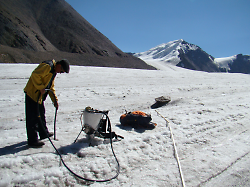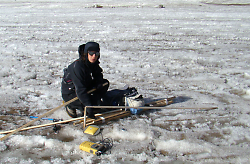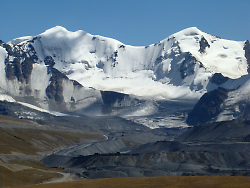New mass balance measurements on Tien Shan and Alay glaciers
In a three week expedition in August 2012, a multi-national team of researchers from Kyrgyzstan, Germany, Switzerland and Austria measured the 2011/2012 ablation and accumulation on four glaciers in the Tien Shan and Alai mountains, among them the Golubin and the Abramov glaciers. The data will be used to compute the 2011/2012 mass balances of the glaciers.
The team was joined by researchers from the Central-Asian Institute for Applied Geosciences (CAIAG), GFZ German Research Centre for Geosciences, Ludwig-Maximilians-Universität Munich, University of Fribourg, World Glacier Monitoring Service WGMS, and the University of Vienna. From August 10th to 30th, 2012, the group visited four glaciers in the Tien Shan and Alay mountains where regular measurements had been resumed in the past two years in the frame of the CAWa project and the CATCOS project of WGMS.
Investigated glaciers and measurements


The investigated glaciers included the Golubin glacier in the Ala-Archa river basin, the Abramov glacier in the Vakhsh river basin, Suek No. 419 glacier in the Zuek Range, and No. 354 glacier in the Akshiirak massif, the latter two in the Naryn basin. At the glaciers, the researchers read the existing ablation stakes, which had been installed in the past two years, and installed new ablation stakes to measure next season’s ablation. Additionally, snow depth and snow water equivalent were measured in the accumulation areas of all four glaciers, and the snow lines were traced using GPS. All the data from the accumulation and ablation areas will be used to compute this season’s glacier mass balances. The mass balance records will later be integrated into the WGMS data base to provide continuous mass balance time series.
As additional information, the glacier tongue outlines were mapped using GPS to assess glacier terminus retreat.
The computed mass balances of the Golubin glacier and glaciers No. 354 and 419 will also be integrated in a hydrological model for the Ala-Archa and Naryn river basins. It is expected that this will improve our understanding of how glacier melting contributes to river runoff which is an important step towards the assessment of future changes in river runoff.
Maintenance of permanent monitoring station at Abramov Glacier

In the frame of the expedition, also the existing permanent hydrometeorological monitoring station at Abramov glacier was maintained, which had been installed in August 2011. As part of this station, two automatic cameras installed in summer 2011 are monitoring the seasonal snow line evolution on the Abramov glacier. One complete annual snow line dataset is now available for further investigations. With the help of the snow line cameras, monthly or even daily glacier mass change over one year, which is crucial for analyzing e.g. the importance of glacier melt contribution to the hydrological cycle, can be determined.
The continuation of the mass balance measurements at selected glaciers in the Tien Shan and Alai mountains is a substantial contribution to the re-establishment of continuous glacier monitoring in Central Asia.
We acknowledge the strong support of the CATCOS project (Capacity Building and Twinning for Climate) lead by the GCOS office Switzerland at MeteoSwiss and financed by Swiss Agency for Development and Cooperation.
Опубликовано Katy Unger-Shayesteh в